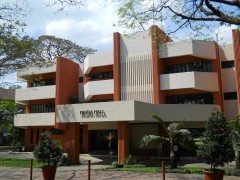“Memristor: Past, Present, and Future”–a talk by Prof. Leon Chua
October 30, 2013 Leave a comment

An array of 17 purpose-built oxygen-depleted titanium dioxide memristors built at HP Labs, imaged by an atomic force microscope. The wires are about 50 nm, or 150 atoms, wide. (Source: Wikipedia)
The School of Science and Engineering and the Office of International Relations, through the Leong Initiative for Internationalization, invites Faculty and students of Biology, Chemistry, ECCE and Physics to a
Distinguished Lecture on Electronic and Information Engineering
by PROFESSOR LEON CHUA
MEMRISTOR: Past, Present and Future
Date : Monday, November 18, 2013
Time : 2:00 pm
Venue : Dr. Ricardo and Rosita Leong Hall Auditorium
About the Speaker:
Professor Leon Chua received his MS and PhD degrees from the Massachusetts Institute of Technology and the University of Illinois at Champaign-Urbana. He is currently a Professor of Electrical Engineering and Computer Sciences at the University of California, Berkeley.
He was the first recipient of the IEEE Gustav Robert Kirchhoff Award in 2005 and was awarded the IEEE Neural Networks Pioneer Award in 2000. He received many international prizes, including the IEEE Browder J. Thompson Memorial Prize and the IEEE W.R.G. Baker Prize. He is the recipient of seven USA patents and 12 Honorary doctorates from universities in Europe and Japan.
He was elected a foreign member of the European Academy of Sciences and the Hungarian Academy of Sciences. In 2010, he was awarded a John Guggenheim Fellow and the Leverhulme Trust Visiting Professorship.
In 2011, he was awarded a Royal Academy of Engineering Distinguished Visiting Fellowship within Imperial College London.

Conceptual symmetry between the resistor, capacitor, inductor, and the memristor. (Source: Wikipedia)
Abstract:
The memristor, short for memory resistor, is the fourth fundamental circuit element. Its invention by Professor Leon Chua in 1971 explained hysteretic effects that had until then been considered random phenomena. Memristors were proposed as the right stuff for building low-power, laptop size, adaptive brain-like computers that could outperform existing supercomputers in many tasks, such as face recognition and dynamic associative memory. Recent advances in nanotechnology are capable of taking memristors to the next level where they can replicate the complexities of the brain.
The memristor behaves like a pipe whose diameter varies according to the amount and direction of charge passing through it. If the flow charge is stopped, the pipe’s diameter stays the same until it is switched on again, remembering the amount of current that has passed through it.
In this special lecture, Prof. Chua introduces the memristor and explains the theory behind it as well as the future ahead of it.

